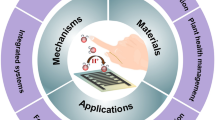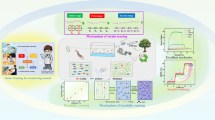Abstract
Flexible pressure sensors, which are employed in robotic arms and electronic skin, are conventionally prepared using methods such three-dimensional printing, laser scribing, and spray coating. However, they are time-consuming and unsuitable for large-scale production. Thus, to overcome these limitations, roll-to-roll (R2R)-based fabrication techniques have been employed for low-cost mass production of flexible pressure sensors. Gravure printing is a promising R2R based technique, but it faces limitations in terms of ink-flow and printing defects causing short circuit, which may affect the performance of printed electronic devices. In this study, we analyzed the effects of printing conditions, web speed, tension, and nip pressure on the drag-out tail defects and conductance in the gravel printing process. We statistically optimized the optimal conditions to obtain minimum drag-out tail defects and conductance using a Box–Behnken design. We also fabricated two flexible pressure capacitive sensors using the conductive patterns to verify optimal conditions. Our results showed that the resistance decreased with increasing web speed, tension, and nip pressure, whereas the drag-out tail increased with increasing tension and nip pressure and decreasing web speed. Additionally, under the optimal conditions, the resistance and drag-out tail severity were improved by 74% and 53%, respectively, over those of the conventionally printed pattern. Finally, using the two flexible pressure capacitive sensors, we showed that the sensor using the conductive pattern had a higher sensitivity after optimization.













Similar content being viewed by others
References
Choi, H., & Jeong, S. (2018). A review on eco-friendly quantum dot solar cells: Materials and manufacturing processes. International Journal of Precision Engineering and Manufacturing-Green Technology, 5(2), 349–358.
Lee, Y. H., Chang, I., Cho, G. Y., Park, J., Yu, W., Tanveer, W. H., & Cha, S. W. (2018). Thin film solid oxide fuel cells operating below 600 C: A review. International Journal of Precision Engineering and Manufacturing-Green Technology, 5(3), 441–453.
Wang, S., Huang, K. H., & Yang, Y. J. (2019). A Highly Sensitive Capacitive Pressure Sensor with Microdome Structure for Robot Tactile Detection. In 2019 20th International Conference on Solid-State Sensors, Actuators and Microsystems & Eurosensors XXXIII (TRANSDUCERS & EUROSENSORS XXXIII) (pp. 458–461). IEEE.
Fastier-Wooller, J., Dinh, T., Dau, V. T., Phan, H. P., Yang, F., & Dao, D. V. (2018). Low-cost graphite on paper pressure sensor for a robot gripper with a trivial fabrication process. Sensors, 18(10), 3300.
Pfeifer, R., Lungarella, M., & Iida, F. (2012). The challenges ahead for bio-inspired’soft’robotics. Communications of the ACM, 55(11), 76–87.
Zhu, Y., Li, J., Cai, H., Wu, Y., Ding, H., Pan, N., & Wang, X. (2018). Highly sensitive and skin-like pressure sensor based on asymmetric double-layered structures of reduced graphite oxide. Sensors and Actuators B: Chemical, 255, 1262–1267.
Chen, D., & Pei, Q. (2017). Electronic muscles and skins: a review of soft sensors and actuators. Chemical Reviews, 117(17), 11239–11268.
Zang, Y., Zhang, F., Di, C. A., & Zhu, D. (2015). Advances of flexible pressure sensors toward artificial intelligence and health care applications. Materials Horizons, 2(2), 140–156.
Ai, Y., Hsu, T. H., Wu, D. C., Lee, L., Chen, J. H., Chen, Y. Z., & Chueh, Y. L. (2018). An ultrasensitive flexible pressure sensor for multimodal wearable electronic skins based on large-scale polystyrene ball@ reduced graphene-oxide core–shell nanoparticles. Journal of Materials Chemistry C, 6(20), 5514–5520.
Kim, K. H., Hong, S. K., Jang, N. S., Ha, S. H., Lee, H. W., & Kim, J. M. (2017). Wearable resistive pressure sensor based on highly flexible carbon composite conductors with irregular surface morphology. ACS Applied Materials & Interfaces, 9(20), 17499–17507.
Zhuo, B., Chen, S., Zhao, M., & Guo, X. (2017). High sensitivity flexible capacitive pressure sensor using polydimethylsiloxane elastomer dielectric layer micro-structured by 3-D printed mold. IEEE Journal of the Electron Devices Society, 5(3), 219–223.
Shi, J., Wang, L., Dai, Z., Zhao, L., Du, M., Li, H., & Fang, Y. (2018). Multiscale hierarchical design of a flexible piezoresistive pressure sensor with high sensitivity and wide linearity range. Small (Weinheim an der Bergstrasse, Germany), 14(27), 1800819.
Wang, R., Kwon, H. J., Tang, X., Ye, H., Park, C. E., Kim, J., & Kim, S. H. (2020). Slot-die coating of sol–gel-based organic–inorganic nanohybrid dielectric layers for flexible and large-area organic thin film transistors. Applied Surface Science, 529, 147198.
Noh, J., Yeom, D., Lim, C., Cha, H., Han, J., Kim, J., & Cho, G. (2010). Scalability of roll-to-roll gravure-printed electrodes on plastic foils. IEEE Transactions on Electronics Packaging Manufacturing, 33(4), 275–283.
Nguyen, H. A. D., Shin, K., & Lee, C. (2015). Effect of nip force on ink transfer in high resolution roll-to-roll printing. International Journal of Precision Engineering and Manufacturing, 16(3), 517–523.
Shin, K. H., Nguyen, H. A. D., Park, J., Shin, D., & Lee, D. (2017). Roll-to-roll gravure printing of thick-film silver electrode micropatterns for flexible printed circuit board. Journal of Coatings Technology and Research, 14(1), 95–106.
Lee, C., & Shin, K. H. (2013). A mathematical model to predict surface roughness and pattern thickness in roll-to-roll gravure printed electronics. Robotics and Computer-Integrated Manufacturing, 29(4), 26–32.
Lee, T. M., Lee, S. H., Noh, J. H., Kim, D. S., & Chun, S. (2010). The effect of shear force on ink transfer in gravure offset printing. Journal of Micromechanics and Microengineering, 20(12), 125026.
Lee, C., Kang, H., Kim, C., & Shin, K. (2010). A novel method to guarantee the specified thickness and surface roughness of the roll-to-roll printed patterns using the tension of a moving substrate. Journal of Microelectromechanical Systems, 19(5), 1243–1253.
Kang, H., & Lee, C. (2015). Effect of tension on conductivity of gravure printed ag layer in roll-to-roll process. International Journal of Precision Engineering and Manufacturing, 16(1), 99–104.
Kitsomboonloha, R., Morris, S. J. S., Rong, X., & Subramanian, V. (2012). Femtoliter-scale patterning by high-speed, highly scaled inverse gravure printing. Langmuir, 28(48), 16711–16723.
Nguyen, H. A. D., Lee, C., Shin, K. H., & Lee, D. (2015). An investigation of the ink-transfer mechanism during the printing phase of high-resolution roll-to-roll gravure printing. IEEE Transactions on Components, Packaging and Manufacturing Technology, 5(10), 1516–1524.
Lee, S., & Na, Y. (2010). Analysis on the ink transfer mechanism in R2R application. Journal of Mechanical Science and Technology, 24(1), 293–296.
Nguyen, H. A. D., Lee, J., Kim, C. H., Shin, K. H., & Lee, D. (2013). An approach for controlling printed line-width in high resolution roll-to-roll gravure printing. Journal of Micromechanics and Microengineering, 23(9), 095010.
Kim, S., Lee, J., Jo, M., & Lee, C. (2020). Numerical modeling of ink widening and coating gap in roll-to-roll slot-die coating of solid oxide fuel cell electrolytic layer. Polymers, 12(12), 2927.
Nikitin, P. V., Lam, S., & Rao, K. V. S. (2005). Low cost silver ink RFID tag antennas. In 2005 IEEE Antennas and Propagation Society International Symposium (Vol. 2, pp. 353–356). IEEE.
Lee, J., Park, J., Jeong, H., Shin, K. H., & Lee, D. (2016). Optimization of printing conditions for microscale multiline printing in continuous roll-to-roll gravure printing. Journal of Industrial and Engineering Chemistry, 42, 131–141.
Hawkins, W. E. (2002). Web Stability. The plastic film and foil web handling guide (pp.3–19). Boca Raton: CRC Press.
Lee, J., Byeon, J., & Lee, C. (2020). Fabrication of Thickness-Controllable Double Layer Electrolyte Using Roll-to-Roll Additive Manufacturing System. International Journal of Precision Engineering and Manufacturing-Green Technology, 1–8.
Jo, M., Lee, J., Kim, S., Cho, G., Lee, T. M., & Lee, C. (2020). Web unevenness due to thermal deformation in the roll-to-roll manufacturing process. Applied Sciences, 10(23), 8636.
Lee, J., Byeon, J., & Lee, C. (2020). Theories and Control Technologies for Web Handling in the Roll-to-Roll Manufacturing Process. International Journal of Precision Engineering and Manufacturing-Green Technology, 1–20.
Park, J., Kim, S., & Lee, C. (2018). An analysis of pinned edge layer of slot-die coated film in roll-to-roll green manufacturing system. International Journal of Precision Engineering and Manufacturing-Green Technology, 5(2), 247–254.
Candioti, L. V., De Zan, M. M., Cámara, M. S., & Goicoechea, H. C. (2014). Experimental design and multiple response optimization. Using the desirability function in analytical methods development. Talanta, 124, 123–138.
Kim, S., Lee, J., & Lee, C. (2019). Computational fluid dynamics model for thickness and uniformity prediction of coating layer in slot-die process. The International Journal of Advanced Manufacturing Technology, 104(5–8), 2991–2997.
Yeo, L. P., Yan, Y. H., Lam, Y. C., & Chan-Park, M. B. (2006). Design of experiment for optimization of plasma-polymerized octafluorocyclobutane coating on very high aspect ratio silicon molds. Langmuir, 22(24), 10196–10203.
Acknowledgements
This work was supported by a National Research Foundation of Korea (NRF) grant funded by the Korea Government (MIST) (No. 2020R1A2C1012428) & (No. 2020R1A5A1019649).
Funding
This work was supported by a National Research Foundation of Korea (NRF) grant funded by the Korea Government (MIST) (No. 2020R1A2C1012428) & (No. 2020R1A5A1019649).
Author information
Authors and Affiliations
Corresponding author
Ethics declarations
Conflict of interest
This manuscript has not been published or presented elsewhere in part or in entirety and is not under consideration by another journal. We have read and understood your journal’s policies, and we believe that neither the manuscript nor the study violates any of these. There are no conflicts of interest to declare.
Additional information
Publisher's Note
Springer Nature remains neutral with regard to jurisdictional claims in published maps and institutional affiliations.
Supplementary Information
Below is the link to the electronic supplementary material.
Rights and permissions
About this article
Cite this article
Jo, M., Lee, J., Kim, S. et al. Resistance Control of an Additively Manufactured Conductive Layer in Roll-to-Roll Gravure Printing Systems. Int. J. of Precis. Eng. and Manuf.-Green Tech. 8, 817–828 (2021). https://doi.org/10.1007/s40684-021-00345-4
Received:
Revised:
Accepted:
Published:
Issue Date:
DOI: https://doi.org/10.1007/s40684-021-00345-4




